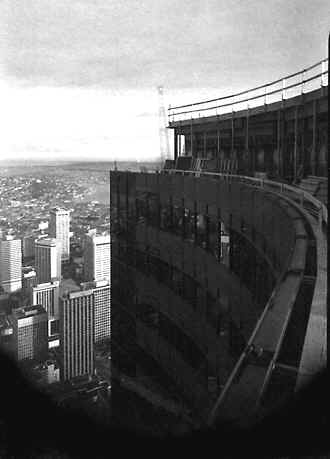Like many prospective freshmen, I was first introduced to Denny Hall during a tour of the University of Washington. My tour guide captioned it the oldest building on campus. Since then, I’ve come to know Denny Hall rather well, though I’m not sure I’ll ever make sense of its seemingly nonsensical layout. Recently, it seems I may have come across an explanation for the building’s current arrangement.
Designed by Charles W. Saunders, Denny Hall was originally constructed in1895, at which time it was designated the Administration Building. At the end of the 19th century, it was large enough to serve the university’s full student body as well as the faculty. It housed classrooms, a library, and a large amphitheater situated in the back of the building. However, decades down the line would see the UW student body increased significantly. Strapped for space and anticipating even more growth in the future, the UW looked to Denny Hall (so renamed in 1910) as an affordable opportunity. Plans for a renovation budget were approved in 1954, and again in 1974. Below are plans for the second floor dated 1894 and 1956 respectively. Notice that the auditorium has been converted into classrooms by 1956.
Though endeared to some for its enduring history, Denny’s primary appeal was its foundation. The interior could be reworked for less than it would have taken to build a comparably sturdy though considerably newer structure elsewhere; meanwhile the exterior would remain for the most part unchanged, the legacy of the UW’s earlier architectural and historical achievements.

Students posed on the steps of Denny Hall (then the Administration Building), 1904. Photo courtesy of UW Libraries Digital Collections.
Denny Hall has undergone numerous other changes since its establishment, including remodeling for the Anthropology Department. Even today it’s slated for renovation in the near future, at which time the Anthropology Department will be moved to Condon Hall. Even so, Denny Hall stands as a sort of palimpsest. Every so often its internal workings are metaphorically erased and rewritten. The only traces of past structures appear to be the twists, turns, and chronological disorder that characterize its halls and rooms. In this way, Denny encompasses remembrance and progress all in one—the adaptation of old materials to accommodate new needs.
Fig. 1. “$1,400,000 Renovation of Denny Hall Set.” (1954). The Seattle Times 35. http://infoweb.newsbank.com.offcampus.lib.washington.edu/iw-search/we/HistArchive/?p_product=EANX&p_theme=ahnp&p_nbid=K54B58YSMTQzMDQ1Mjg4Ny41OTc5MTE6MToxMzoxMjguOTUuMTA0LjY2&p_action=doc&s_lastnonissuequeryname=10&d_viewref=search&p_queryname=10&p_docnum=1&p_docref=v2:127D718D1E33F961@EANX-12B7340296A3F623@2434777-12B72FEFD85B78B1@33-12B74C64E3F57990@
Fig. 2. Saunders, Charles W. Second Floor Plan. 1894, Architectural drawing. Available from: Campus Engineering Facilities Records, https://fsweb1.u.washington.edu/docsearch/sql/facrecframes.asp?build_id=54534756245B4B5D9FD29E690D21401F&build_name=DENNY%20HALL&build_num=001
Fig. 3. Baar, Granger & Thomas Baar. Second Floor Plan. 1956, Architectural drawing. Available from: Campus Engineering Facilities Records, https://fsweb1.u.washington.edu/docsearch/sql/facrecframes.asp?build_id=54534756245B4B5D9FD29E690D21401F&build_name=DENNY%20HALL&build_num=001
Fig. 4. 1904 Campus Day showing students on Denny Hall steps, University of Washington. 1904, Photograph image. Available from: University of Washington Libraries Digital Collections, http://digitalcollections.lib.washington.edu/cdm/singleitem/collection/uwcampus/id/852/rec/2



















